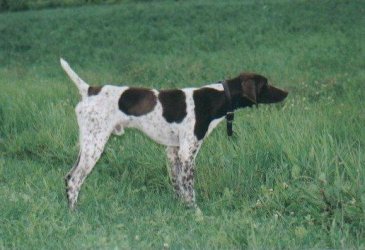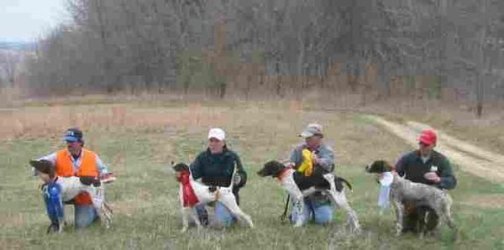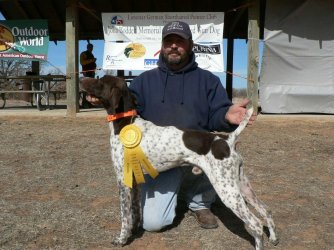Great work Buck. I grew up using Old Hickory knives when we butchered. They are good knives and usually bring decent money still around here at sales.Not hunting related but I received a few of my grandmothers old hickory butcher knives. This one had a cracked handle with one missing rivet. So I decided to make and fit a new handle. I settled on some scrap pieces of persimmon for its toughness and character. I drilled out and replaced the rivets with torx head inserts. I sealed the handles and put them on the next night. They should last another 50 years
Thanks
BuckView attachment 566126
You are using an out of date browser. It may not display this or other websites correctly.
You should upgrade or use an alternative browser.
You should upgrade or use an alternative browser.
Ramblings and Such From Hunting Coyote
- Thread starter DSheetz
- Start date
 Help Support Long Range Hunting Forum
Help Support Long Range Hunting Forum
- Joined
- Nov 25, 2012
- Messages
- 273
Looks great!Not hunting related but I received a few of my grandmothers old hickory butcher knives. This one had a cracked handle with one missing rivet. So I decided to make and fit a new handle. I settled on some scrap pieces of persimmon for its toughness and character. I drilled out and replaced the rivets with torx head inserts. I sealed the handles and put them on the next night. They should last another 50 years
Thanks
BuckView attachment 566126
IMHO, Persimmon and Dogwood are two excellent but overlooked woods for knife scales.
Ed
HRM Johnny
Well-Known Member
Way to go Buck.
Its been sharpened a few times!!!Not hunting related but I received a few of my grandmothers old hickory butcher knives. This one had a cracked handle with one missing rivet. So I decided to make and fit a new handle. I settled on some scrap pieces of persimmon for its toughness and character. I drilled out and replaced the rivets with torx head inserts. I sealed the handles and put them on the next night. They should last another 50 years
Thanks
BuckView attachment 566126
I got called one evening to see when I could meet the rancher and his sons to locate for the helicopter for them. I set up to meet them in two days and was going to be with the dad and the two sons were going to be in another location. The pilot contacted me when he was up and nearing our location. I ran my siren and had nearly instantons replies from two groups. The boys wanted the helicopter first, so I sent it to them. It hunted for the coyotes for some time but didn't get on them so started my way. I told him where the closet ones had been down in some deep draws, he flew in the area and about three hundred yards out got on the pair. They dropped the first one then got on the second one and got it about 50 yards from us. The rancher was going I've never had a coyote shot from the helicopter that close to me I wouldn't want them after me. I put them on the second coyote group, and they got the pair and saw the den. So, I headed to it and left the rancher to go to where his sons were. I got to the den and took 6 pups out of it then called the rancher and told him I would go to where the sons had heard the coyotes and see what I could come up with. I was going up a cow trail near the location when a coyote jumped out from under a big sage brush and ran stopped to look at me and got shot. I dropped into a big draw and was walking up it toward a spring when I spotted a nice hole with a lot of puppy tracks and scat close to it in the bottom of the draw facing south. I plugged the hole with my jacket went and got my truck and tools. I set up and started working on the hole the female was in the hole along with five pups. Here where I am most of the dens that I have taken both red fox and coyote have been situated to face south, even the ones in a small hill side, in a draw or cut bank and even the ones in rock piles. I'm not sure about the rest of the country, but I figure that it might have to do with our altitude and cooler weather, as we can still have some pretty deep snows here for a couple of more weeks.
The antelope and deer here will start to have their fawns the end of May or the first Part of June. Lambing season will be starting around the 12th. to the 15th. of May here. Calving is pretty much done now here. The rabbits and prairie dogs as well as mice and other rodents are having their young now.
- Joined
- Nov 25, 2012
- Messages
- 273
Antelope and deer should be starting in about a week or so here, spring calving is over and the next group will calve in early fall.The antelope and deer here will start to have their fawns the end of May or the first Part of June. Lambing season will be starting around the 12th. to the 15th. of May here. Calving is pretty much done now here. The rabbits and prairie dogs as well as mice and other rodents are having their young now.
Rabbits, what few there are, are having their young now, and the feral swine never stop breeding so they are still increasing in numbers.
I saw a sow on one of my trail cameras today that should be having her litter any day now. All of her teats that I could see were full, but no shoats were with her.
I saw my first Western Diamondback of the year today, a little three-footer with an attitude of a hormonal 13 year old.
No livestock on the range I was working, so he got a pass. They have their place in the food chain and they serve as mice and rat control as well as food for coyotes, bobcats, hawks, and owls.
Ed
Sneuses
Well-Known Member
I had an ole dog named Willie. He was breed to hunt upland game, never put a bird in the air and retrieved kindly to had. There are many wonderful experiences I've had with this dog. But I could tell you by his tail set many things. If he was working pheasant he had a 12 o'clock tail set, quail or chuckar it was 10 o'clock both very well focused head. If the game moved off he still had a ten o'clock stick but he would look at me to ask can I move ahead and relocate? Then there were other times after I told him it was ok by touching his ear to go ahead and relocate he would go ahead and do it on his own. After relocating he would let you know what he was into by his tail set.When you have been around a person , or dog long enough you learn how they speak under different conditions . When I get excited I might talk faster , louder and in a different tone . When my dog is close to an animal it might talk faster in a higher pitch and a chop instead of a bawl . When a dog hits a deer trail it might talk faster higher pitched then when it hits a coyote track . Dogs say different things for different animals at different tones and paces when you have been around them you learn to hear the subtle differences in their voice and know what it is that they are talking about . Reemty J . isn't that about how you would describe it ? They have a language the same as we do it's a matter of learning to interpret it and being able to hear the differences they have to say . Darn I need to charge my hearing aids lol .
I owned this dog since he was a six week old pup. He slept in the same bed as me, as I believe your animals learn from you constantly and that promotes a special bond that is unbreakable. But as you see him and I went to campaigning. I ran him in local, regional and national events. He was finished as FC Antrims Willie McJeebers. On his left side there was a liver heart shape just before his tail, God put that on him for me as we had each others
Attachments
Last edited:
I have had several good dogs but one that really stood out to me. I have a good Jack Russel now he just wants to please and is very vocal but with whines and little chirps. He will growl and bark at times or when my wife's little dog gets to pestering him too much. We are just now getting some rabbits back I started seeing some last fall. We lost all of the different species we had the cottontails two species that we have here, and the jack rabbits and snowshoe hairs all died back to nearly nonexistent. I'm glad to see more of them around. Thankfully we don't have feral pigs here. I saw a heavy swift fox yesterday she should be whelping any day. I have had more than one call of coyote pups that turned out to be swift fox. One guy even told me about some grey fox that were the little swifts. They eat a lot of small rodents as well as ground nesting birds and their eggs or young.
I was out checking snares one fall when I went past one of the crawl under sets in a fence a big western diamond back was laying in the hole sunning itself. I cut its head off and buried it as I was taught to when I was a kid then hung it on the fence. A couple of days later I was coming through making my checks as I looked down the fence from about half a mile out something looked kind of odd down by where I had killed the snake, I got my binoculars out and looking down there I saw a big bobcat setting there eating the snake like a piece of spaghetti while it hung on the fence. And that might be why one of the lure and bait makers from Montana makes a bait from rattle snakes. It takes a special kind of person not to be bothered at a rattle snake den. the snakes have a bad smell but it's the buzzing of all of them and the numbers of them crawling around that makes the hair on my neck stand on end.
- Joined
- Nov 25, 2012
- Messages
- 273
Two ways to use rattlesnakes in your predator bait.
First is to grind the whole snake up and use it as an additive to your other meat, whether it's horse, bobcat, or rodent, and let that age for a while.
Second is to take a section of PVC pipe longer than the snake, having cut the tail off, stretch the snake out in the pipe with the head sticking out just enough to hold it in place, set the pipe up at about a 45* angle with the tail down and a Mason jar under it to catch the liquids.
Place this setup in the sun where it gets full exposure and leave it for several days.
You will see the yellowish oil rendering out and collecting into the jar.
This should NOT be done in your suburban yard or anywhere near people with a weak stomach.

The stench of rotten rattlesnake will stick around for a long time!
The "Snake Oil" is a very good additive to baits and lures but it doesn't take much at all to work. A few drops will do it.
Bobcats in particular love to eat snakes and you're just ringing the dinner bell when you use snake.
Ed
First is to grind the whole snake up and use it as an additive to your other meat, whether it's horse, bobcat, or rodent, and let that age for a while.
Second is to take a section of PVC pipe longer than the snake, having cut the tail off, stretch the snake out in the pipe with the head sticking out just enough to hold it in place, set the pipe up at about a 45* angle with the tail down and a Mason jar under it to catch the liquids.
Place this setup in the sun where it gets full exposure and leave it for several days.
You will see the yellowish oil rendering out and collecting into the jar.
This should NOT be done in your suburban yard or anywhere near people with a weak stomach.
The stench of rotten rattlesnake will stick around for a long time!
The "Snake Oil" is a very good additive to baits and lures but it doesn't take much at all to work. A few drops will do it.
Bobcats in particular love to eat snakes and you're just ringing the dinner bell when you use snake.
Ed
It's fascinating to me what the animals eat. I have learned a lot about their diets when I was denning, red fox are some of the dirtiest dens you will find. They bring all sorts of things back for the kits to eat and play with. I don't recall a red fox den that didn't have at least one snakes remains at it. they will have animal legs, birds, rodents and bones laying around them. I only remember one dirty coyote den she was a runted female and was only a yearling without a male helping her as I had killed him earlier during the breading season and she hadn't picked up another helper. Her tracks were close to the size of a red foxes tracks. I believe that she was a survivor of being orphaned by one of the guys that swore if he took the adults all of the pups would die too. Anyway, back to her den it was filthy and had all kinds of decaying animals and parts laying around when I saw it, I got a little confused because I was looking for a coyote den in the area where I had taken her that morning, she showed four pups. When I wired the first coyote pup out of the hole, I was surprised thinking that I had found a fox den in her area, as a bonus. Most of the bobcat dens I have seen were pretty clean, they seem to leave the dens pretty young and start traveling with mom. She will stash them, and hunt brings food back to where she left them. I had some M-44's set for coyote pups one year that had moved into a pasture. as I was checking them, I found my stake signs were gone. I found them all chewed up and laying some distance from my sets. Tracks and the bite marks told me it was bobcat kittens, latter I saw five smaller kittens sunning and playing just a few hundred yards away in a rock pile. Mice, birds, eggs, prairie dogs, snakes, frogs, lizard's, insects are all on the menu, as well as a lot of plants.
Ohiolongarm posted a picture of a wet female the other day on the lets see some coyotes. I have seen that the majority of them pulled the soft fur on their bellies out and used it to line their den holes before the pups were born giving the pups a clean place to nurse her as well as a warm nesting place. This time of the year here in cooler climates and higher altitudes we get some heavy wet snows at times and as with all newborn animals when they get wet and chill, they will get phenomena, a hard spring storm will kill more coyote pups here than mankind can. The more I was around coyotes at all times of the years the more I saw so many of the things that they did which amazed me. When I get to looking at some of the things that they do when they are raising pups as a family group, I have to admire them for it. Both adults raising the pups, sometimes keeping another young coyote with them to help raise them, if one gets killed, especially the female, they will bring in another helper, often they will adopt other coyote's pups if the adults get killed, all of these and more things over time will give you an opportunity to understand why they are survivors.
Last edited:


